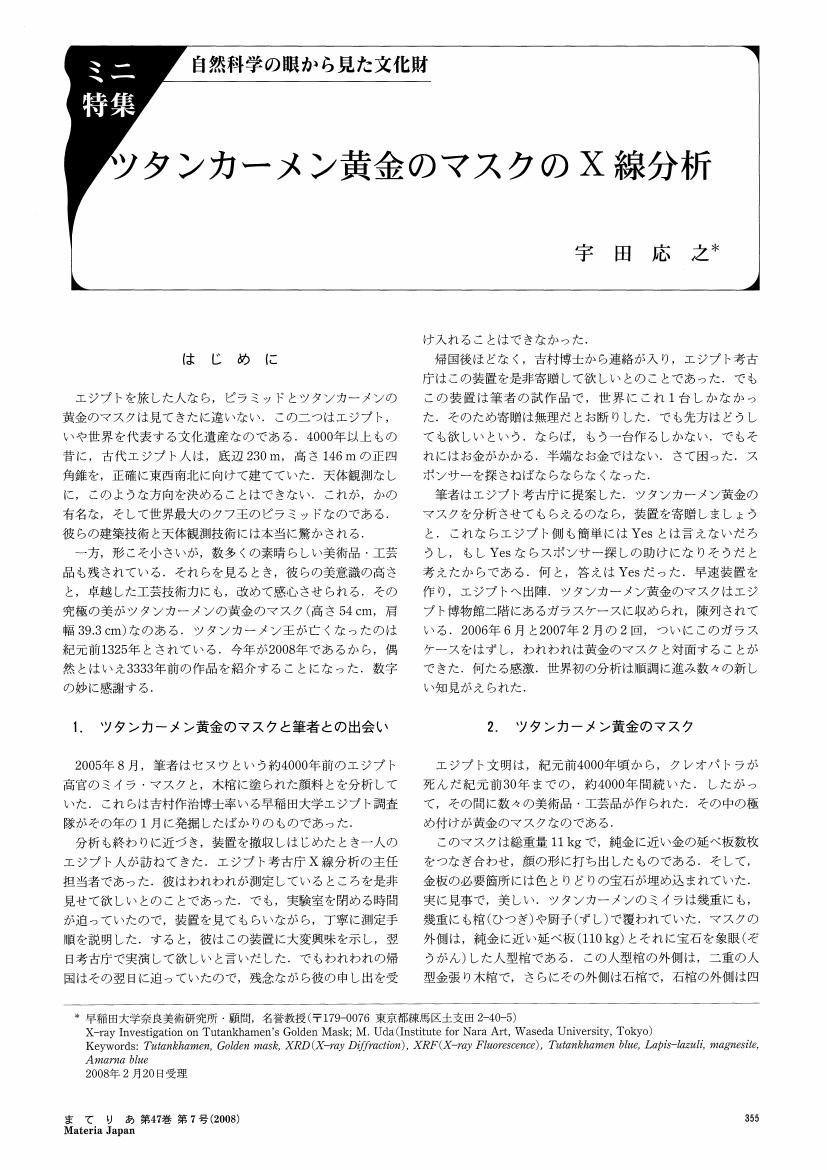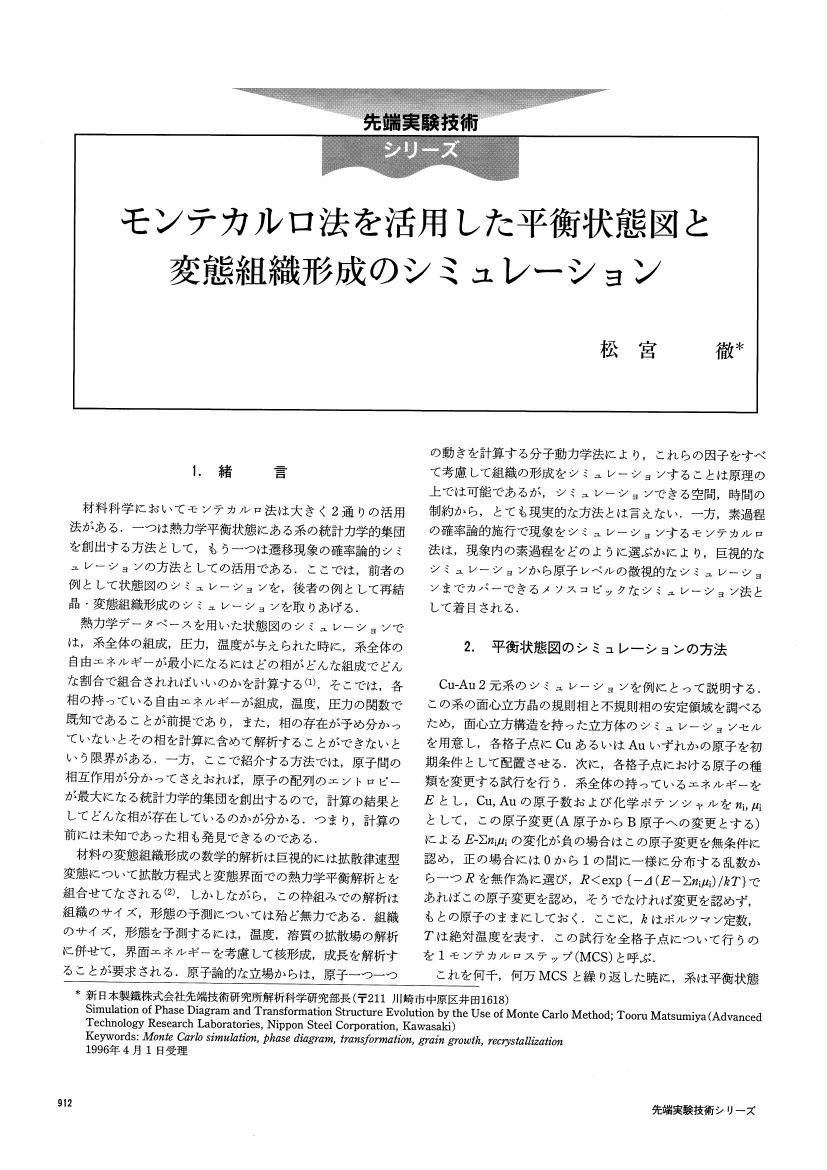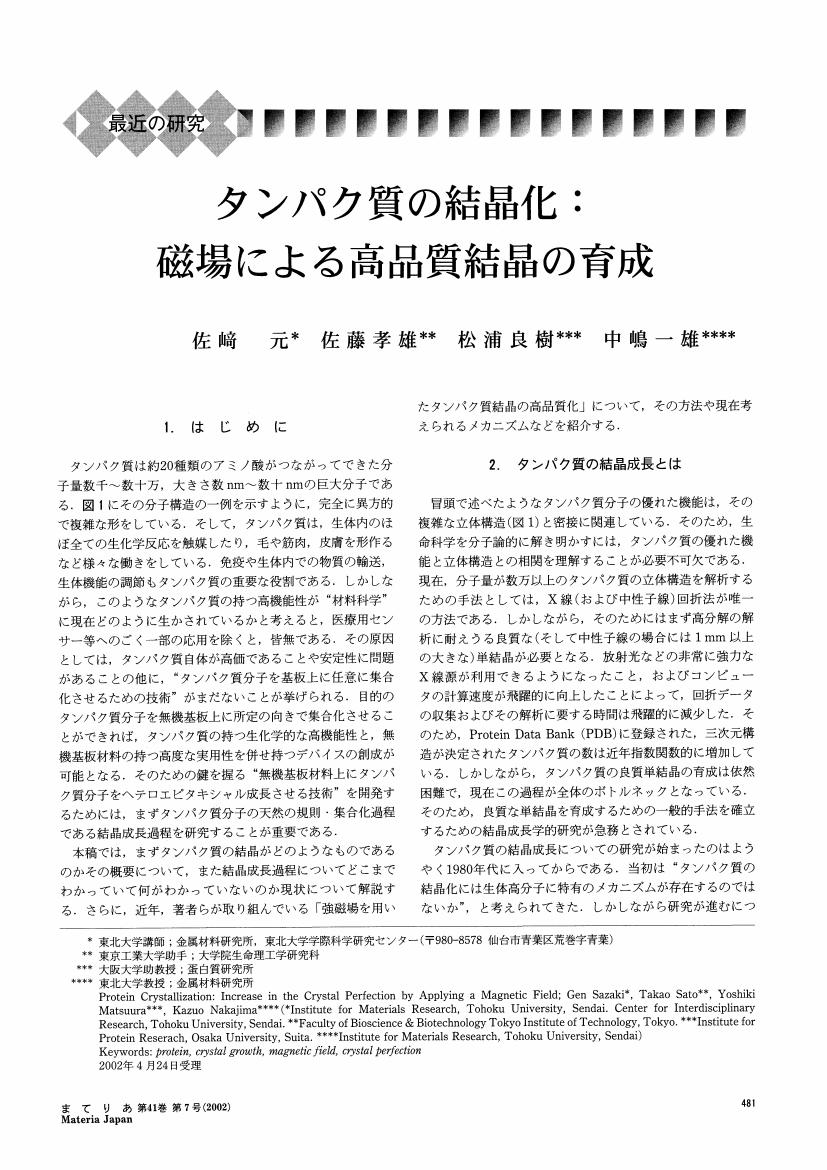354 0 0 0 OA 爆轟エネルギーによる成形加工
- 著者
- 藤田 昌大
- 出版者
- 公益社団法人 日本金属学会
- 雑誌
- まてりあ (ISSN:13402625)
- 巻号頁・発行日
- vol.36, no.5, pp.464-467, 1997-05-20 (Released:2011-08-11)
- 参考文献数
- 6
- 被引用文献数
- 1 1
257 0 0 0 OA 鉄道車両が求める軽量金属の材料特性
- 著者
- 水田 明能 木村 敏宣
- 出版者
- 公益社団法人 日本金属学会
- 雑誌
- まてりあ (ISSN:13402625)
- 巻号頁・発行日
- vol.43, no.5, pp.392-395, 2004-05-20 (Released:2011-08-11)
- 参考文献数
- 8
- 被引用文献数
- 2 3
44 0 0 0 OA ツタンカーメン黄金のマスクのX線分析
- 著者
- 宇田 応之
- 出版者
- 公益社団法人 日本金属学会
- 雑誌
- まてりあ (ISSN:13402625)
- 巻号頁・発行日
- vol.47, no.7, pp.355-358, 2008-07-01 (Released:2011-08-11)
- 参考文献数
- 9
24 0 0 0 OA 1950∼1960年代の東海道新幹線車軸の開発とリスク・マネジメント
- 著者
- 辛島 恵美子
- 出版者
- 公益社団法人 日本金属学会
- 雑誌
- 日本金属学会誌 (ISSN:00214876)
- 巻号頁・発行日
- vol.66, no.12, pp.1236-1245, 2002 (Released:2008-04-24)
- 参考文献数
- 27
The Shinkansen Line has experienced no serious car-accidents since its operation start in 1964. Why has the Shinkansen Line been able to keep such a good safety performance? This paper intends to clarify the background and the reasons why those miracles became possible—when, what kinds of risks and what kinds of actions the staff of the Japanese National Railways took in, who participated in the development of the Tokaido Shinkansen railway-axles in 1950s∼1960s as a designer, an investigator, a maintenance engineer, an inspector, or a top executive in technology. I discovered all the staff had been dedicated to their duties and their actions were prudent enough in general. As a result their behaviors have reduced the riskiness of their works objectively. But the most of the staff were not so much sensitive to risk itself as a few technical top executives of JNR. For example when the inspectors first found unexpected micro cracks on the 20% running axles in 1965, the top executives adapted a new management system in 1966 based on those inspections, which contained a systematic long-range R&D plan of high-quality railway-axles as well as an effective risk management for micro cracks.
23 0 0 0 OA 高速鉄道車両への難燃性マグネシウム合金の適用
18 0 0 0 OA 地熱発電所における防食およびスケール対策
- 著者
- 広渡 和緒
- 出版者
- 公益社団法人 日本金属学会
- 雑誌
- まてりあ (ISSN:13402625)
- 巻号頁・発行日
- vol.35, no.3, pp.215-219, 1996-03-01 (Released:2011-08-11)
- 参考文献数
- 8
16 0 0 0 OA 蕨手刀
- 著者
- 高橋 信雄
- 出版者
- 公益社団法人 日本金属学会
- 雑誌
- まてりあ (ISSN:13402625)
- 巻号頁・発行日
- vol.34, no.10, pp.1144-1148, 1995-10-20 (Released:2011-08-11)
- 参考文献数
- 10
10 0 0 0 OA 金-銀合金および金-銅合金のヤング率ならびにそれに対する熱処理および加工の影響について
- 著者
- 梅川 莊吉
- 出版者
- 公益社団法人 日本金属学会
- 雑誌
- 日本金属学会誌 (ISSN:00214876)
- 巻号頁・発行日
- vol.18, no.8, pp.449-452, 1954 (Released:2008-04-04)
- 参考文献数
- 6
- 被引用文献数
- 2
Young’s modulus and its change accompanied by heat-treatment and by cold-working in gold-silver and gold-copper alloys has been measured by lateral vibration method of a cantilever under small amount of stress. The composition dependence of Young’s modulus is monotonous in both alloy systems. Young’s modulus of Cu3Au increases and of CuAu decreases the superlattice formation. The effect of cold work on Young’s modulus is similar for some gold-silver alloys, but it differs considerably with some gold-copper alloys.
10 0 0 0 OA モンテカルロ法を活用した平衡状態図と変態組織形成のシミュレーション
- 著者
- 松宮 徹
- 出版者
- 公益社団法人 日本金属学会
- 雑誌
- まてりあ (ISSN:13402625)
- 巻号頁・発行日
- vol.35, no.8, pp.912-917, 1996-08-20 (Released:2011-08-11)
- 参考文献数
- 11
- 被引用文献数
- 1 1
9 0 0 0 OA 室町時代末期から江戸時代の鎧に用いられた鎖の製作方法
- 著者
- 釘屋 奈都子 永田 和宏 北田 正弘
- 出版者
- 公益社団法人 日本金属学会
- 雑誌
- 日本金属学会誌 (ISSN:00214876)
- 巻号頁・発行日
- vol.78, no.4, pp.149-158, 2014 (Released:2014-04-01)
- 参考文献数
- 14
- 被引用文献数
- 1 4
The manufacturing technique of steel chains used for four Japanese armatures from the end of Muromachi to the Edo period has been investigated. The chains used in Kusazuri (tasset) and two types of Kote (guntlet) were composed of steel rings in round and oval shapes while those used in Kusarikatabira (chainmail) was only round. As for the former ones, round rings were connected by oval rings. The diameter of steel wire of rings was about 1 mm. The steel wire was produced from steel plate with the carbon content of 0.11 to 0.40 mass%. Steel was forge-and-welded twice to make in plate and was cut in a bar. The steel bar was drawn into standardized wires by die with the draft percentage of about 25% and annealed. Drawing of standardized wire followed by annealing was repeated several times to make a wire for armatures. The crystal grains in wires were elongated in axial direction and the aspect ratio of grain in oval rings was larger than that in round rings. A wire was rolled around a stick and cut by chisel to make rings.
7 0 0 0 OA 室町時代末期から江戸時代に製作された槍刀身の金属組織
- 著者
- 杉岡 奈穂子 北田 正弘 西嶋 雅彦
- 出版者
- 公益社団法人 日本金属学会
- 雑誌
- 日本金属学会誌 (ISSN:00214876)
- 巻号頁・発行日
- vol.77, no.5, pp.185-191, 2013 (Released:2013-05-01)
- 参考文献数
- 15
- 被引用文献数
- 2
The metallurgical microstructure and mechanical properties of the spear blade manufactured in the Edo period have been investigated. The purpose of this work is to obtain metallographic data of the spear blade, and to clarify the manufacturing technique of the spear blade. The specimen examined was estimated to have been made from the end of the Muromachi period to the Edo period and has the signature of Shinano-no-Kami Minamoto Takamichi. The spear is 31 cm in length and 10.7 mm in maximum width. The metallurgical microstructure and nonmetallic inclusions of the spear blade are observed using an optical microscope. The carbon concentration is determined by chemical analysis. To evaluate the hardness, micro Vickers hardness (Hmv) is used. The microstructure is observed using an optical microscope and a scanning electron microscope (SEM). The concentration of nonmetallic inclusions is obtained by electron dispersive X-ray analysis (EDS). A cross-sectional image of the spear after chemical etching shows a metal flow pattern formed by deformation, possibly created by hammering. The striped structure of layers of two types of steel containing different carbon contents stacked on top of each other was observed. The bright areas after etching corresponded to the edges and ridges of the spear, which were cooled rapidly, forming the martensite structure. The other dark areas consist of pearlite and α-Fe (ferrite) grains. Optical micrographs of near-edge areas contain pearlite and martensite grains, and core areas contain pearlite and α-Fe grains. The nonmetallic inclusions in the core steel consist of a few metal oxide particles and a glass matrix. There are Fe-Ti oxide grains in the glass matrix, and an unknown oxide particle adhering on the Fe-Ti oxide grain surface was also observed.
6 0 0 0 OA 超ジュラルミン24S(2024)はなぜ米国で開発できたか?
- 著者
- 吉田 英雄
- 出版者
- 公益社団法人 日本金属学会
- 雑誌
- まてりあ (ISSN:13402625)
- 巻号頁・発行日
- vol.57, no.6, pp.263-270, 2018 (Released:2018-06-01)
- 参考文献数
- 47
- 被引用文献数
- 1 1
6 0 0 0 OA サルモネラ菌の硫化水素産生能を用いた銅の抗菌性評価
- 著者
- 翠川 裕 仲井 正昭 翠川 薫 新家 光雄
- 出版者
- 公益社団法人 日本金属学会
- 雑誌
- 日本金属学会誌 (ISSN:00214876)
- 巻号頁・発行日
- vol.80, no.3, pp.165-170, 2016 (Released:2016-02-25)
- 参考文献数
- 10
A novel method for detecting antimicrobial activity using an innate property of the Salmonella bacteria, namely, the ability of Salmonella to produce hydrogen sulfide (H2S) was developed in this study. The effectiveness of the method was evaluated by comparing the antibacterial activity of copper to that of aluminum. Salmonella was inoculated over the entire surface of deoxycholate hydrogen sulfide lactose (DHL) agar plates that included Ammonium ferric citrate (C6H8FeN). Approximately 25 μL of cupric chloride (CuCl2, 1% weight ratio) solution or aluminum chloride (AlCl3, 1% weight ratio) solution was added to the center of the medium. The surface of the medium was covered with plastic PET (polyethylene terephthalate) material to induce an anaerobic state. Salmonella was cultured under anaerobic conditions at 310 K (37℃) for 86.4 ks (24 h). The antibacterial activity of copper was determined by observing the medium surface color change due to iron sulfide (FeS) formation, which was caused by the production of H2S by Salmonella; blackness indicated presence of newly formed FeS. A quantitative evaluation of copper's antimicrobial activity was performed using a gradient of CuCl2 concentrations; results were compared with those of the present standard method, Kirby-Bauer disk diffusion method on the Mueller Hinton medium. Finally, in order to evaluate the antibacterial activity of metals, Salmonella was inoculated on DHL agar plates. Subsequently, Japanese coins (1 yen, 5 yen, 10 yen, 50 yen, 100 yen and 500 yen coins) were placed on the agar and cultured at 310 K for 86 ks. Salmonella cultured in the presence of AlCl3 produces black color, while no blackening is observed with CuCl2, suggesting that copper possesses an antibacterial property against Salmonella. CuCl2 suppresses H2S production by Salmonella, as Cu2+ forms a transparent circle or ellipse (new halo) around the point at which CuCl2 had has been plated. The size of the new halo increases in direct proportion to the concentration of CuCl2. The halo is no longer visible at 0.034 mg of CuCl2 in our method, while the halo disappears with 4.34 mg of CuCl2 in the Kirby-Bauer method. Therefore, the present method is 129 times more sensitive than the standard method, suggesting increased usefulness and effectiveness in testing antibacterial activity. No FeS-dependent black circle is formed under any of the coins, with the exception of the 1-yen coin, which contains aluminum and no copper. Therefore, the copper-containing coins have an antibacterial effect.
6 0 0 0 OA アレニウスと反応速度論
- 著者
- 小岩 昌宏
- 出版者
- 公益社団法人 日本金属学会
- 雑誌
- まてりあ (ISSN:13402625)
- 巻号頁・発行日
- vol.39, no.1, pp.58-62, 2000-01-20 (Released:2011-08-11)
- 参考文献数
- 13
5 0 0 0 OA 超音波・マイクロ波励起反応場を利用したナノ・マイクロ材料創成
- 著者
- 林 大和
- 出版者
- 公益社団法人 日本金属学会
- 雑誌
- まてりあ (ISSN:13402625)
- 巻号頁・発行日
- vol.53, no.11, pp.541-545, 2014 (Released:2014-11-01)
- 参考文献数
- 12
- 被引用文献数
- 1 2
5 0 0 0 OA 自動車用ハイテン材の現状
- 著者
- 齋藤 和也
- 出版者
- 公益社団法人 日本金属学会
- 雑誌
- まてりあ (ISSN:13402625)
- 巻号頁・発行日
- vol.53, no.12, pp.584-588, 2014 (Released:2014-12-01)
- 参考文献数
- 7
- 被引用文献数
- 19 28
5 0 0 0 OA 日本刀-その材料, 鍛錬および焼入れのシミュレーション
- 著者
- 井上 達雄
- 出版者
- 公益社団法人 日本金属学会
- 雑誌
- まてりあ (ISSN:13402625)
- 巻号頁・発行日
- vol.35, no.2, pp.174-178, 1996-02-01 (Released:2011-08-11)
- 参考文献数
- 15
- 被引用文献数
- 2 2
5 0 0 0 OA タンパク質の結晶化: 磁場による高品質結晶の育成
- 著者
- 佐崎 元 佐藤 孝雄 松浦 良樹 中嶋 一雄
- 出版者
- 公益社団法人 日本金属学会
- 雑誌
- まてりあ (ISSN:13402625)
- 巻号頁・発行日
- vol.41, no.7, pp.481-488, 2002-07-20 (Released:2011-08-11)
- 参考文献数
- 40
5 0 0 0 OA 原子力の教育と研究はどうあるべきか ─福島原発事故の反省を出発点として─
- 著者
- 井野 博満
- 出版者
- 公益社団法人 日本金属学会
- 雑誌
- まてりあ (ISSN:13402625)
- 巻号頁・発行日
- vol.52, no.4, pp.153-157, 2013 (Released:2013-04-10)
- 参考文献数
- 13
- 被引用文献数
- 1
4 0 0 0 OA たたら製鉄とその金属学
- 著者
- 清永 欣吾
- 出版者
- 公益社団法人 日本金属学会
- 雑誌
- まてりあ (ISSN:13402625)
- 巻号頁・発行日
- vol.33, no.12, pp.1453-1458, 1994-12-20 (Released:2011-08-11)
- 参考文献数
- 26
- 被引用文献数
- 6 6














